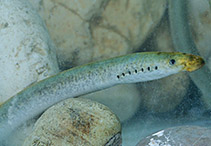| Family: |
Petromyzontidae (Northern lampreys), subfamily: Lampetrinae |
| Max. size: |
26 cm TL (male/unsexed); max. reported age: 6 years |
| Environment: |
demersal; freshwater, non-migratory |
| Distribution: |
Europe: Alpine slope of Po to Soca drainages (Italy, Switzerland, Slovenia), Esino and Potenza drainages on Adriatic coast of Central Italy; Mirna (Croatia) and Neretva drainage (Bosnia-Herzegovina, Croatia). |
| Diagnosis: |
Adults: 11.8-15.6 cm TL. Body proportions, as percentage of TL (based on 19 specimens measuring 11.8-15.6 cm TL): prebranchial length, 10.2-13.7; branchial length, 9.3-11.9; trunk length, 45.5-52.6; tail length, 24.0-28.7; eye length, 1.6-2.5; disc length, 4.6-6.9. Urogenital papilla length, as a percentage of branchial length, in six spawning males measuring 12.8-13.9 cm TL, 23.5-40.0. Trunk myomeres, 54-60. Dentition: supraoral lamina, 2 unicuspid teeth; infraoral lamina, 5-8 unicuspid teeth, usually 7; three endolaterals on each side; endolateral formula, typically 2-3-2 (2-2-2 in the holotype); 2 rows of anterials; first row of anterials, 4 unicuspid teeth; 0-1 row of exolaterals on each side; single incomplete row of posterials with 2-5 unicuspid teeth (2 in the holotype); transverse lingual lamina, 5-7 unicuspid teeth, the median one enlarged; longitudinal lingual laminae each with about 6 or 7 unicuspid teeth. Velar tentacles, 3-5, with tubercles. Body coloration (preserved), dorsal and lateral aspects grayish, ventral surface whitish, dorsal fins and caudal fin yellowish. No dark blotch near the apex of the second dorsal fin. Lateral line neuromasts unpigmented. Caudal fin shape, spade-like. |
| Biology: |
Freshwater (Ref. 89241, 12320). Occurs in clean, cold water usually near springs in the foot-hill zone, over muddy or sandy bottom (Ref. (Ref. 12320). Ammocoetes inhabits detritus-rich sands or clay sediments (Ref. 59043). They are filter bottom-feeders. Metamorphosis takes place after 4.5 years (Ref. 12320). Short-lived, non-parasitic (Ref. 12320, 89241). Reproduction takes place from January to June. Its existence is threatened by habitat destruction and water abstraction (Ref. 26100). |
| IUCN Red List Status: |
Near Threatened (NT); Date assessed: 28 December 2023 (Near Threatened) Ref. (130435)
|
| Threat to humans: |
harmless |
Source and more info: www.fishbase.org. For personal, classroom, and other internal use only. Not for publication.
